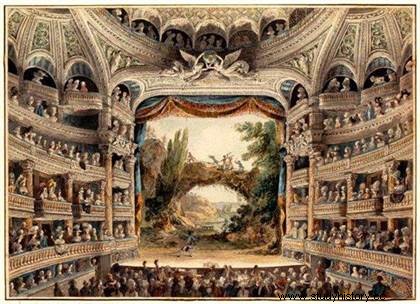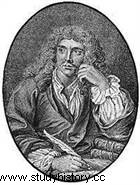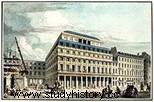 The oldest national theater in the world, the Comédie Française was created by an edict from King Louis XIV, which merged two major Parisian theater companies, the Guénégaud (resulting from an association in 1673 of the Illustre Théâtre of the late Molière with the Théâtre du Marais) and the Hôtel de Bourgogne. Until 1790, the unified company was granted the monopoly of all new performances of French plays. The Comédie-Française , had the motto “Simul et Singulis” – being together and being yourself – with a beehive and bees as its emblem.
The oldest national theater in the world, the Comédie Française was created by an edict from King Louis XIV, which merged two major Parisian theater companies, the Guénégaud (resulting from an association in 1673 of the Illustre Théâtre of the late Molière with the Théâtre du Marais) and the Hôtel de Bourgogne. Until 1790, the unified company was granted the monopoly of all new performances of French plays. The Comédie-Française , had the motto “Simul et Singulis” – being together and being yourself – with a beehive and bees as its emblem.
French comedy:birth of an institution
Molière led a troupe at the Palais Royal in 1670, but competition was fierce:two other troupes existed at the Marais and at the Hôtel de Bourgogne. In 1673, after Molière's death, his Illustre Théâtre company joined forces with a rival troupe, the Théâtre du Marais, and began performing under the name Théâtre du Guénégaud.
In 1680, by virtue of an edict from King Louis XIV, the Guénégaud merged with the oldest troupe in Paris, that of the Hôtel de Bourgogne (where Racine had set up own parts). The unified company is granted the monopoly of all new performances of French plays. It gave its first joint performance on August 25, 1680. The following month, the king consecrated the unique troupe, made up of 27 actors and actresses whom he chose on their exceptional talent to "make the performances of comedies more perfect".
The troupe takes the name of Comédie-Française to distinguish itself from its rival the Comédie-Italienne, a troupe dedicated to the commedia dell'arte; it takes over the abandoned Hôtel de Bourgogne. On October 21, the king signed a letter of cachet decreeing the founding of a single troupe with the aim of "making the performances of comedies more perfect" and granted the monopoly of performances in French. The plays performed by some of the 27 actors chosen by the king are those of Molière, Corneille, Racine, Scarron, Rotrou. As artists, we find Armande Béjart, La Grange, Miss Champmeslé, Du Croisy…
An eventful history
On January 5, 1681, the actors founded an association regulating the pension system in particular. Provided with a pension of 12,000 pounds, the troupe will take the name of “Comédiens du Roy”, but will often be denigrated by Italian artists. This gave rise to the term “Comédie Française”. Too close to the Collège des Quatre-Nations, the troupe had to leave the theater in 1687 and settled in 1689 in the current rue de l'Ancienne Comédie, a new theater built according to the plans of François d'Orbay.
 After the death of Louis XIV in 1716, the troupe had to fight against the Italian Comedians, favored by the Regent . They change repertoire by creating the "tearful comedy" and use the works of Voltaire, Destouches, Nivelle de La Chaussée, Marivaux.
After the death of Louis XIV in 1716, the troupe had to fight against the Italian Comedians, favored by the Regent . They change repertoire by creating the "tearful comedy" and use the works of Voltaire, Destouches, Nivelle de La Chaussée, Marivaux.
Thanks to Louis XV, who settled the troupe's debts in 1766, the French transformed the theater by creating boxes, enlarging the stage, making the sets and costumes more natural. Settling in the Tuileries Palace in 1770, they presented the Barber of Seville by Beaumarchais in 1775, consecrated Voltaire in 1778, then ensured the triumph of the Marriage of Figaro in 1784 in their new theater in Faubourg Saint Germain, the current Odéon.
When the Revolution arrived, the life and status of French artists changed. The troupe was dissolved in 1792. Losing their royal pension and with the new name of Théâtre de la Nation, they settled in a room recently built by Victor Louis, but on September 3, 1792, the Comité de Salut Public closed the Odéon , arrests the actors, seizes their papers and imprisons them. Thanks to Charles Labussière, an employee of the Committee of Public Safety, they avoided the guillotine and were freed in 1793 when Robespierre fell.
 It was only in 1799 and thanks to the Directory through the writer François de Neufchâteau , that the French actors can settle in the French Theater of the Republic, rue Richelieu. On April 17, 1804, the members formed a new society whose protector was Napoleon. This is how he established the "Moscow" decree on October 15, 1812, signed in the middle of the Russian campaign, consisting of 87 articles, reorganizing the Comédie-Française, the statutes still being in force today. The members are called Sociétaires, led by Talma until 1826, the date of his death. The Members will appeal to the "Romantics" to increase their repertoire:Alfred de Vigny, Victor Hugo, Alexandre Dumas and on February 25, 1830, they present "Hernani", but Victor Hugo's "Burgraves" in 1843 is a failure, the audience yearning for a more classic tragedy.
It was only in 1799 and thanks to the Directory through the writer François de Neufchâteau , that the French actors can settle in the French Theater of the Republic, rue Richelieu. On April 17, 1804, the members formed a new society whose protector was Napoleon. This is how he established the "Moscow" decree on October 15, 1812, signed in the middle of the Russian campaign, consisting of 87 articles, reorganizing the Comédie-Française, the statutes still being in force today. The members are called Sociétaires, led by Talma until 1826, the date of his death. The Members will appeal to the "Romantics" to increase their repertoire:Alfred de Vigny, Victor Hugo, Alexandre Dumas and on February 25, 1830, they present "Hernani", but Victor Hugo's "Burgraves" in 1843 is a failure, the audience yearning for a more classic tragedy.
Louis Napoléon overhauled the administrative functioning of the Comédie Française in 1849 by creating the post of administrator and it became the "troop ordinary of the Emperor" in 1859. Until n 1871, it was the triumph of “bourgeois comedy” with characters like Sarah Bernhardt and authors such as Banville, Ponsard, Augier. All of Paris went to the theatre, but between 1885 and 1913 the financial difficulties were there, the actors were brilliant in the "tragic", the "comic" was less and "moral" comedies appeared. It must be said that the theater fire in March 1900 did not make things any easier:a disaster was avoided and for safety reasons, the number of seats was gradually reduced from 2,000 to 900 currently.
During the First World War and up to the Second, the Comédie Française performed “patriotic” theatre. Despite the troubles, new playwrights as well as foreign authors are welcomed. This is how names such as Louis Jouvet, Mauriac, Pirandello are read and prestige is preserved during the war.
The theaters of the Comédie Française
The Comédie Française will perform in two venues:the Salle Richelieu and the Salle Luxembourg or the Odéon. In the years following the end of the war, on several occasions, the Odéon was part of the Comédie, then was definitively withdrawn in 1988. But places were sorely lacking:in 1993, the Théâtre du Vieux Colombier was assigned to it as the second room and in 1996 a new room was opened at the Carrousel du Louvre.
 The Comédie Française is today a public institution of an industrial and commercial nature, dependent on the Ministry of Culture. But according to the statutes initiated by Napoleon, the members are boarders and associates under the leadership of the dean.
The Comédie Française is today a public institution of an industrial and commercial nature, dependent on the Ministry of Culture. But according to the statutes initiated by Napoleon, the members are boarders and associates under the leadership of the dean.
"Residents" are members hired by the Administrator, who are part of the troop and have less than a year of presence. They become "Sociétaires" after one year of seniority, chosen by the Administrative Committee and by order of the Ministry of Culture. They pass to the status of "Honorary Members" after twenty years of presence, when they are retired. They are thus recognized for their quality work and can play from time to time in the troupe. The "Dean" is the oldest member, leading the troupe and ensuring that the original principles are maintained.
The Comédie Française, as we have read, has a monopoly on performances in French. Its repertoire, made up of 3,000 plays, uses the great classics, but it also features foreign authors such as Shakespeare and more modern ones such as Ionesco and Beckett. Molière is and will remain the most played author:more than 30,000 times since the creation of the troupe with his most represented known plays:the "Tartuffe", the "Avare", the "Misanthrope", the "Médecin Imaginaire and the "Doctor in spite of himself". Its current administrator is Éric Ruf.
Bibliography
- History of the Comédie-Française:From Molière to Talma by André Blanc. Perrin, 2007.
- Great and short history of the Comédie-Française:The Age of Enlightenment 1680-1799 by Maurice Lever. Fayard, 2006.
